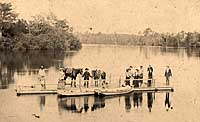 The town and natural spring, both with name Fanning or Fannin Springs, are in the southwestern corner of Gilchrist County on the Suwannee River. It was there that Fort Fanning was built in November, 1838, during the Seminole Indian War (18351842) and named for Major Alexander Campbell Wilder Fanning, who had served with Andrew Jackson in Florida. It was built to protect a much used crossing of the Suwannee River.
The town and natural spring, both with name Fanning or Fannin Springs, are in the southwestern corner of Gilchrist County on the Suwannee River. It was there that Fort Fanning was built in November, 1838, during the Seminole Indian War (18351842) and named for Major Alexander Campbell Wilder Fanning, who had served with Andrew Jackson in Florida. It was built to protect a much used crossing of the Suwannee River.
Fanning was born in Boston, Massachusetts, in 1788, graduated from West Point in 1812, and fought against the British in the War of 1812, for which service he was appointed major. In 1818, he fought with Andrew Jackson against the Seminole Indians in Florida. After serving different posts, Fanning was commissioned major of artillery in 1832.
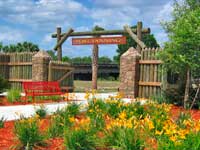 He was in Florida at the outbreak of the Seminole War in 1835 and was picked for a special commendation for gallant conduct at the Battle of the Withlacoochee. Before the war ended he was transferred to the Canadian frontier and died in Cincinnati, Ohio, on August 18, 1846.
He was in Florida at the outbreak of the Seminole War in 1835 and was picked for a special commendation for gallant conduct at the Battle of the Withlacoochee. Before the war ended he was transferred to the Canadian frontier and died in Cincinnati, Ohio, on August 18, 1846.
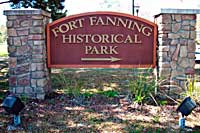 After the building of Fort Fanning, federal troops occupied it for about four or five years, during which time thirty one soldiers died in or near the fort; twenty seven died from disease, one was shot to death, two died of wounds previously received, and one drowned. All were probably buried near the fort, the site of which is about 200 yards north of Highway 19.
After the building of Fort Fanning, federal troops occupied it for about four or five years, during which time thirty one soldiers died in or near the fort; twenty seven died from disease, one was shot to death, two died of wounds previously received, and one drowned. All were probably buried near the fort, the site of which is about 200 yards north of Highway 19.
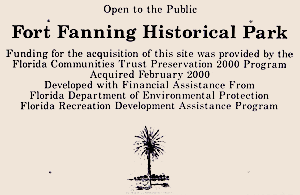 The settlement around the fort was known as Palmetto or Sikesville, but gradually took its name from the fort. A post office was established there in 1846 or 1847 with Thomas C. Love as postmaster, it was discontinued in 1852, reinstated in 1855, changed to Sikesville in1857, and finally discontinued in the 1860’s. When it was reestablished in 1888, it was called Fannin. In 1906, service moved to Trenton in 1912.
The settlement around the fort was known as Palmetto or Sikesville, but gradually took its name from the fort. A post office was established there in 1846 or 1847 with Thomas C. Love as postmaster, it was discontinued in 1852, reinstated in 1855, changed to Sikesville in1857, and finally discontinued in the 1860’s. When it was reestablished in 1888, it was called Fannin. In 1906, service moved to Trenton in 1912.
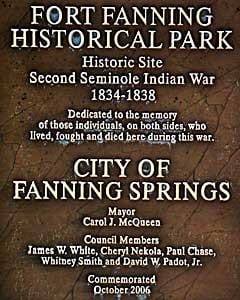 More and more people began settling in the area with their families to farm, fish and hunt. One writer described the place in 1888 in the glowing terms: “The country is sparsely settled, game is abundant, and some of the finest timbered lands in the county are to be found in this locality.” A ferry, connecting both sides of the Suwannee, continued to operate until a wooden turnbridge was built. A steel bridge would replace that bridge in 1935. Later, a concrete bridge was added when the road was four laned
More and more people began settling in the area with their families to farm, fish and hunt. One writer described the place in 1888 in the glowing terms: “The country is sparsely settled, game is abundant, and some of the finest timbered lands in the county are to be found in this locality.” A ferry, connecting both sides of the Suwannee, continued to operate until a wooden turnbridge was built. A steel bridge would replace that bridge in 1935. Later, a concrete bridge was added when the road was four laned
Richard Tison, assisted by his young nephew, Sam Hardee, owned and operated a General Store, cotton gin, corn mill, and livery stable near the public ferry. A year after a fire destroyed his store in 1905; Mr. Tison rebuilt it in Trenton with Sam Hardee as his partner.
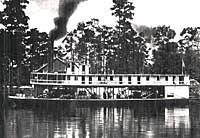 A few automobiles used the dusty roads in the area in the early 1900’s, but the harsh conditions took their toll on the vehicles. Many visitors to Fanning Springs, especially in the hot summer months, took advantage of the clear, cool water for picnics, camping, political gathering, and big Fourth of July celebrations. The springs, located in the present day Levy County across the highway, became the recreation center for the residents in the surrounding towns.
A few automobiles used the dusty roads in the area in the early 1900’s, but the harsh conditions took their toll on the vehicles. Many visitors to Fanning Springs, especially in the hot summer months, took advantage of the clear, cool water for picnics, camping, political gathering, and big Fourth of July celebrations. The springs, located in the present day Levy County across the highway, became the recreation center for the residents in the surrounding towns.
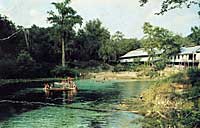 Many short term businesses were setup around the Springs, especially in the summer months, and a few lasted for a number of years. For example, Fred Sundey put in a filling station and sandwich shop just off the bridge in Fanning Springs.
Many short term businesses were setup around the Springs, especially in the summer months, and a few lasted for a number of years. For example, Fred Sundey put in a filling station and sandwich shop just off the bridge in Fanning Springs.
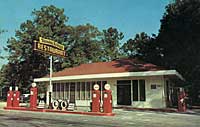 After World War II, Bud Clapp, an Indiana man who had been stationed at Cross City Air Base, opened a filling station and restaurant on the Gilchrist side of the entrance to the Springs. The building he used, which was owned by John Henry Anderson, had sat there unused for a long time. The place grew and changed hands several timed until it finally became the popular Chris’s, a restaurant owned and operated by Chris and Helen Anderson. It later became the widely known Light house Restaurant, owned by James and Sue Nesmith.
After World War II, Bud Clapp, an Indiana man who had been stationed at Cross City Air Base, opened a filling station and restaurant on the Gilchrist side of the entrance to the Springs. The building he used, which was owned by John Henry Anderson, had sat there unused for a long time. The place grew and changed hands several timed until it finally became the popular Chris’s, a restaurant owned and operated by Chris and Helen Anderson. It later became the widely known Light house Restaurant, owned by James and Sue Nesmith.
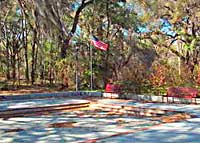 Meanwhile other places were opened in the vicinity, for example the Cadillac Motel and Stucky’s, the latter of which evolved into a discount outlet for towels. Another restaurant, built more than thirty years ago, eventually became RicRic Stephen Foster Barbecue Restaurant.
Meanwhile other places were opened in the vicinity, for example the Cadillac Motel and Stucky’s, the latter of which evolved into a discount outlet for towels. Another restaurant, built more than thirty years ago, eventually became RicRic Stephen Foster Barbecue Restaurant.
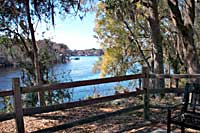 A Shriner’s Clubhouse has recently been added to the area, and the Tri-county Suwannee Valley LiveStock Pavilion has an annual Youth Fair and Livestock sales that attract many visitors. A group of citizens led by A.B. Grandoff hope to build a hospital there to serve the Tri-County area. A Florida State Road Guard Station is located in Fanning, as is the Road Guard Bureau Headquarters. For a number of years, Herbert Brown Sr. of Trenton headed up the Road Guard Inspections Service.
A Shriner’s Clubhouse has recently been added to the area, and the Tri-county Suwannee Valley LiveStock Pavilion has an annual Youth Fair and Livestock sales that attract many visitors. A group of citizens led by A.B. Grandoff hope to build a hospital there to serve the Tri-County area. A Florida State Road Guard Station is located in Fanning, as is the Road Guard Bureau Headquarters. For a number of years, Herbert Brown Sr. of Trenton headed up the Road Guard Inspections Service.
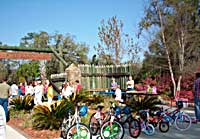 When Brown died, Commissioner of Agriculture Doyle Conner appointed Forrest Beach of Trenton to the post, thus helping to continue the active involvement of the Beach family in the County’s history. Forrest’s brother, Douglas was a Trenton postmaster. Their father, Frank Beach, was a farmer, cattleman, and building contractor, who built both the old wooden gymnasium at Trenton High School and the Church of Christ building near the court house in Trenton. Frank Beach’s widow, Edith, was one of Trenton’s pioneer citizens.
When Brown died, Commissioner of Agriculture Doyle Conner appointed Forrest Beach of Trenton to the post, thus helping to continue the active involvement of the Beach family in the County’s history. Forrest’s brother, Douglas was a Trenton postmaster. Their father, Frank Beach, was a farmer, cattleman, and building contractor, who built both the old wooden gymnasium at Trenton High School and the Church of Christ building near the court house in Trenton. Frank Beach’s widow, Edith, was one of Trenton’s pioneer citizens.
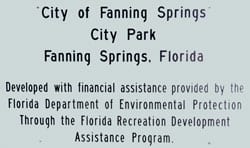 In 1965, the Florida Legislature passed a bill incorporating the community of Fanning Springs, which lay in both Gilchrist and Levy counties, into the town of Suwannee River. For many years there was some dispute as to the spelling of Fanning, whether it should have a final “g” or not. 1977, because the town of Suwannee River was sometimes confused with the town of Suwannee, which was located some 25 miles away where the Suwannee River enters the Gulf of Mexico, voters in the town chose to rename their town, Fanning Springs, with a final “g” on Fanning because an 1847 survey had Fanning on it-with the final “g”.
In 1965, the Florida Legislature passed a bill incorporating the community of Fanning Springs, which lay in both Gilchrist and Levy counties, into the town of Suwannee River. For many years there was some dispute as to the spelling of Fanning, whether it should have a final “g” or not. 1977, because the town of Suwannee River was sometimes confused with the town of Suwannee, which was located some 25 miles away where the Suwannee River enters the Gulf of Mexico, voters in the town chose to rename their town, Fanning Springs, with a final “g” on Fanning because an 1847 survey had Fanning on it-with the final “g”.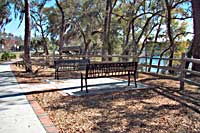
On December 6, 1977, Ordinance Number 77-01 (City Charter) was put in place to develop a Mayor – Council form of government that we continue to use today.
Ordinance 77-01 (City Charter) in its full content is available at the Fanning Springs City Hall.
